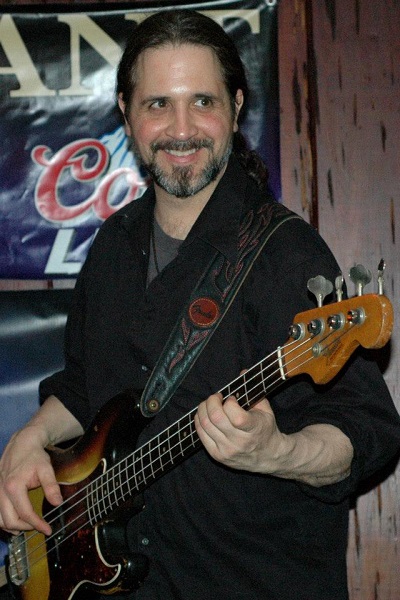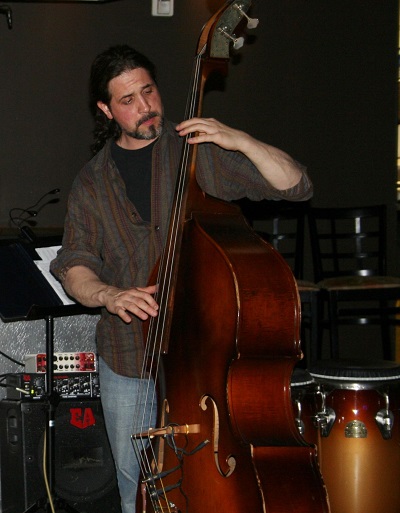

Interview by Roger Zee (06/25/22)
Roger Zee: Who inspired you to take up the bass? Do you sing or play any other instruments?
Billy Bileca:
My interest in music started at a very young age. At seven, I was given eight track cassettes of the Beatles and Dr. John. I wore those out listening to them until the tape got stuck and wouldn’t play anymore.
At eight years old, I asked my mom to order a double album from a commercial on TV called Elvis in Hollywood. I recently purchased the album again and after listening to it, came to realize that the styles of music that set the tone for me all appear on this record -- great Blues shuffles, New Orleans style songs, some Jazzy arrangements. The band jams and it rocks!
Fortunately, I grew up in a neighborhood where a group of us loved music. Like many bassists, I first played guitar and still do, along with ukulele. We would jam in garages or down in the basement. One day at fifteen, a beat-up pawn shop electric bass magically appeared. I picked it up and said I’ll try it.
My early bass influences include John Paul Jones, Phil Lesh, Berry Oakley, Paul McCartney, and John Entwistle. Soon after, I dug into the Blues. Willie Dixon became a big source of inspiration along with Ray Brown, Tommy Shannon, Johnny B. Gayden, Keith Ferguson, and many more. Once I heard James Jamerson on the Motown records, that got me into reading music and wanting to gain more knowledge.
RZ: Tell me about some of the musicians and groups you gigged and recorded with.
BB: I started gigging early on. In our teens, we formed a group called Reeds Exchange. Our keyboardist’s family owned a bar that we started playing at regularly. Underaged and very motivated to gig, we rehearsed often and performed at any dive that would book us.
At nineteen, I started playing gigs with L.A. Jones and he really helped me out in playing different styles of Blues. He ran some great open mics and played shows with Pinetop Perkins, Eddie Kirkland, Otis Rush, and more Blues artists. Sitting in and seeing these musicians really opened my ears up.
In 1992 I moved to California and went to the Grove School of Music. I got a street gig on Route 66 in Pasadena and one with the house band that held an open mic at a joint in Van Nuys. I played on a TV show in the valley, got booked on a few recordings, and worked with a bunch of funky characters. That led to a year's worth of touring with Debbie Davies, Chris D’Amato, and Tim Browne. We covered many miles in a windowless cargo van, losing our minds, selling cassettes at first and then her first CD, "Picture This," on the Blind Pig label which did very well.
All kidding aside, we played some awesome gigs. We felt privileged to open up for and hang out with Albert Collins. Definitely a major highlight. After that, we started the infamous Smokin’ Opey Band. We performed as much as possible throughout the rest of the 90s. That's back when Toad’s Place felt like a great place to play. We had a blast and found ourselves lucky to appear on the bill opening for Buddy Guy and many more.
Since then, I freelanced and became a member of what I call the eight gigs a week club! Very fortunate to play and record with so many excellent CT/NY area musicians.
RZ: What instruments/string/amps/mics do you currently use?
BB: My main electric basses are vintage Fender. I do own some other basses and guitars in my collection that I really like that are also mostly vintage. My ’67 Kay upright's the only one that I’ve ever owned.
I’ve played a David Eden tube head and Eden cabs for over twenty years. My Sunn Model T gets a lot of use. I own five Ampeg B-15’s, Fender amps, and some stuff that I find in the downstairs closet that I've forgotten about... you get the idea!
RZ: Talk about your home studio.
BB: I prefer recording gear that's analog or has that vibe. At home I mostly use a Tascam DP-32 for demos and ideas. I've got an old Tascam 388 that I haven’t used for a bit, but still remains my favorite. Blue makes my best microphones, but of course I also use Shure 57 and 58s.
RZ: What and how do you practice?
BB: I practice all the time. I still love it! If there's a gig or recording that I need to shed for, I always do my best to go in prepared. Reading music's great and can lead to your own ideas.
I like arranging instrumental versions of songs and working them out on bass. On guitar, I’ll do the same. Bending strings like B.B. King never gets old. Playing along to records, or putting a channel on Pandora, Spotify, or Youtube and figuring stuff out keeps the ears fresh. When I studied with Joel Di Bartolo, he would go into my truck and turn the dial on the radio. So that when we heard something that I wouldn’t normally tune in to, he'd say, "Open ears, open mind."
RZ: Tell me about your new book of bass transcriptions just picked up by JW Pepper catalog.
BB: You can pick up my book, "Bass Transcriptions from Louis Armstrong Plays W.C. Handy: Note-for Note Transcriptions of Arvell Shaw" as a paperback or eBook on Amazon.com or at JW Pepper. You can also order spiral bound copies from my website at BassDogMusicCo.com. One of my most favorite albums of all-time. I wish I had this type of book years ago.
In 1954 on July 13th, 14th and 15th, Louis Armstrong and His All Stars recorded "Louis Armstrong Plays W.C. Handy." Consisting of songs written by W.C. Handy, "The Father of the Blues," it's widely considered Armstrong’s best album of the 1950s. The band consisted of Louis Armstrong (trumpet, vocals), Velma Middleton (vocals), Billy Kyle (piano), Trummy Young (trombone), Barney Bigard (clarinet), Barrett Deems (drums), and Arvell Shaw (upright bass). George Avakian produced a band in top form.
The result's a joyous, raucous celebration of some of the finest New Orleans-style Blues ever recorded. W.C. Handy's known as one of the most important and influential Blues composers in history. In 1912, Handy published sheet music in the Blues form for "The Memphis Blues." "Father of the Blues," an autobiography by W.C. Handy, serves as a great read to learn about his life, pioneering efforts, and accomplishments.
The bass lines transcribed in my book came from the album as played by Arvell James Shaw. Arvell, a powerful bassist, played with magnificent tone, technique and stage presence. On each song of the album, bass lines flawlessly support the music.
Bassists at all levels can use this book for upright or electric bass. The reading's not that difficult on the slow/mid tempo songs. Using it with a teacher will help the beginner get started. They can jump in quickly. The basic chord tones and scales make the note choices obvious. You can easily apply basic chord theory when playing through each tune. The fun to play, up-tempo songs can challenge even the advanced player. The book includes two solos that showcase Arvell’s virtuosity and improvisational skills.
For Blues and Jazz bassists who play primarily by ear and would like to begin or add reading music, this book's for you! Keeping it on the stand while an album plays should help you connect with the notes on the page. I hope that learning the bass lines while reading the music will inspire you to gain knowledge. You should find great joy in playing from this book for many years to come!
RZ: Do you teach music privately?
BB: I’ve taught for 27 years. I give lessons on upright bass, electric bass, guitar and ukulele. In that time, I've worked with hundreds of students of all ages and levels. Some went on to become professional musicians and educators. I truly enjoy it and made many great connections with students and their families. I also teach those with special needs. They've been some of favorites to spend time with.
RZ: How has the Pandemic affected you? What's on the horizon?
BB: At the time the Pandemic started, I needed a break and had already scaled back the gigs that I took. But I continued teaching, which sustained me throughout. I adapted and became more proficient on the computer which prior, I hadn’t spent much time learning. I wrote two books that I feel very pleased with. Students and players told me they made excellent progress in using their charts.
On the horizon I’d like to continue writing music and publishing books. I do hope to get back to playing live more often, but I seek an ambitious musical situation where every band member contributes. I enjoy a great appreciation for life and music. I need to continually strive and evolve to feel my best. Staying stagnant's not an option for me.
RZ: Describe your most special and/or unusual gig.
BB: It felt really great opening up for music legends like B.B. King, Buddy Guy, Robert Cray, Albert Collins and more. Playing the Juneteenth Festival in Houston felt memorable in so many ways. Difficult to pick just one. I performed in almost every state in the USA. Playing in Hell, Norway was a good one. Also playing a few impromptu duo gigs with Duke Robillard thrilled and challenged me.
RZ: How do you see the future of the music business?
BB: I like to stay optimistic. People make great music all over the world. Nowadays, musicians need to stay savvy with technology. There can be a lack of traditional income and royalties. But there’s always a way and the world forever changes.
RZ: What advice do you give up-and-coming musicians?
BB: Learn music history and respect the architects. Also really important that you don't get caught up in comparing yourself to others. And practice often!
RZ: Do you live with any animals?
BB: At the moment we don’t keep any pets at home. Some readers may know that we recently lost Lady, the greatest pit bull. Her love for music was genuine and real. She was intense in the best way.
RZ: Anything else you'd like to add?
BB: Thank you Roger for the interview. To all, keep on playing, be kind and take care of yourselves in mind, body and spirit.
YouTube - "Signe" - Solo arrangement of Eric Clapton's Signe played on a Jay Turser Beatle bass
YouTube - "C.M.C." - Paul Gabriel
YouTube - "328 Chauncy Street" - Paul Gabriel
©2022 Roger Zee


GarajDesign, Inc.



